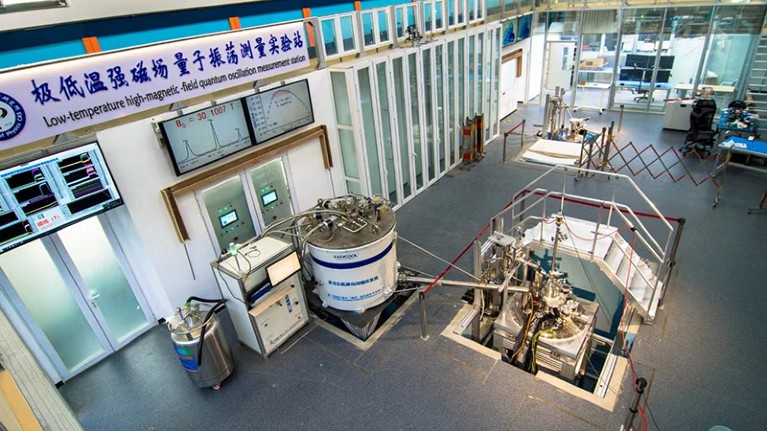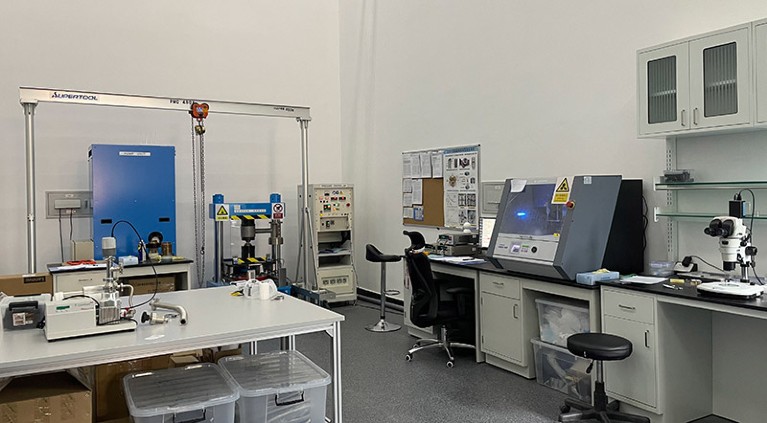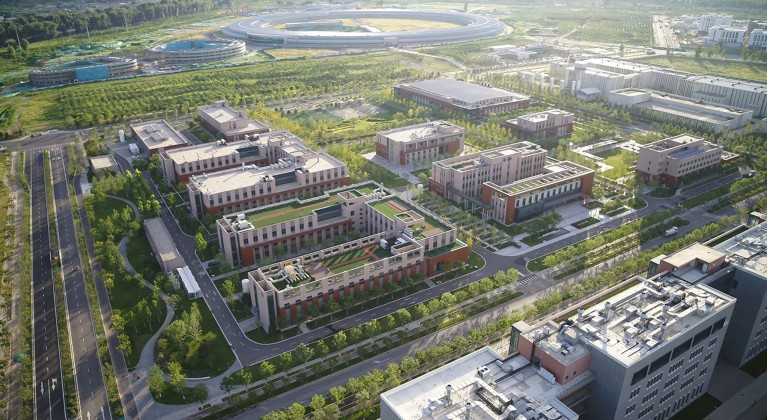Huairou, Beijing
On the outskirts of Beijing sits a set of unassuming buildings marked ‘X’, for ‘extreme’. Inside the Synergetic Extreme Condition User Facility (SECUF), researchers from all over the world are pushing matter to its limits with extreme magnetic fields, pressures and temperatures, and examining it in new ways with extremely precise resolution in time.
One particularly tantalizing goal of many researchers using this US$220-million toolbox is to discover new superconductors, materials that conduct electricity without resistance. “This kind of combination of extreme conditions offers a very good chance for new discoveries,” says SECUF founding director Li Lu, a condensed-matter physicist at the Chinese Academy of Science’s Institute of Physics (IOP) in Beijing.
Understanding the mechanisms that underlie superconductivity is an important step in the global race to finding a material that exhibits this phenomenon at room temperature, instead of under frigid conditions. Such a discovery could open the door to faster computers and cut electricity consumption, among other benefits.
Under extreme conditions, matter exhibits properties that would otherwise remain hidden. For instance, when some ordinary-seeming materials are subjected to high pressures and extreme cold, they become superconductors. But measuring superconductivity can be finicky, because it can show up differently depending on the technique used, says Konstantin Kamenev, a physicist at the University of Edinburgh, UK, who specializes in extreme-conditions engineering and instrumentation. The ability to mix and match such conditions at a single facility allows researchers to characterize their samples more fully and efficiently than they could otherwise. “It’s like a one-stop shop,” says Jinguang Cheng, a condensed-matter physicist at the IOP.
Extreme toolbox
Since September last year, all 22 experimental stations at SECUF have moved to full operation after a one-year trial period. Tucked into a corner of one of SECUF’s brightly lit rooms, Cheng oversees a station that combines a cubic anvil cell — a device that squeezes materials under enormous pressure on six sides — with two superconducting magnets and helium-based cooling systems. The sample-torturing instrument can be used to measure a range of electronic properties and characteristics. Although conventional high-pressure tools, such as diamond anvils, can accommodate samples that are only the width of a human hair, SECUF’s cubic anvil cell can compress larger samples, making it easier to measure electronic properties in finer detail, says Cheng.
He says that he and his colleagues have, in this way, discovered a handful of superconductors, including a rare magnetic one1 and another based on manganese2.

The quantum oscillation station combines two superconducting magnets with ultra-low temperatures. Credit: Institute of Physics, Chinese Academy of Sciences
Behind a yellow warning barrier at the other end of the room sits a powerful superconducting magnet. Rui Zhou, a condensed-matter physicist at the IOP, and his colleagues have set up a station that combines the magnet with ultra-low temperatures to perform nuclear magnetic resonance (NMR) measurements. The technique tracks the behaviour of atomic nuclei in high magnetic fields. It offers a way of peering into the mechanisms that underlie high-temperature superconductors — those that operate above −195.8 °C.
SECUF’s magnet produces a weaker field — just 26 tesla — than do those at other facilities, such as the record-holding 45-T hybrid magnet, which is partially superconducting, at the US National High Magnetic Field Laboratory (NHMFL) in Tallahassee, Florida, and the 37-T resistive magnet at France’s National Laboratory for Intense Magnetic Fields in Grenoble, which require a lot of power to run. But it can maintain a stable magnetic field for up to one month instead of a few days or hours, because it guzzles much less power, says Zhou. That makes it possible for researchers to conduct longer experiments on the same sample, he explains.

The cubic anvil cell is located on the back wall, with black and yellow hazard tape. It can accommodate much larger samples than other high-pressure devices.Credit: Institute of Physics, Chinese Academy of Sciences
Another magnet system is enabling other types of superconductivity research. Gang Li, a condensed-matter physicist at the IOP, heads a station that combines blisteringly cold temperatures with a 30-T superconducting magnet and a 20-T one to detect quantum oscillations — physical phenomena that are used to map the electronic ‘fingerprint’ of materials. Last July, Alexander Eaton, a condensed-matter physicist at the University of Cambridge, UK, and his colleagues spent two weeks using the station to unpick the electronic properties of an unusual superconductor called uranium ditelluride3. “It was the only place we could do the experiment we wanted to do,” says Eaton.
Mix and match
Other superconductivity researchers are using multiple tools at SECUF. Guanghan Cao, a condensed-matter physicist at Zhejiang University in Hangzhou, China, used the cubic anvil cell and NMR to probe an intriguing chromium-based material he had discovered by accident. Cao and his colleagues spotted hints of superconductivity when they subjected it to high pressures using the cubic anvil cell4. Over at the NMR station, the researchers were also able to catch a glimpse of the compound’s magnetic properties. The ability to measure the material in multiple ways in one location enabled the researchers to conduct a more in-depth study in less time. “That’s really convenient for us,” Cao says.
Superconductivity isn’t the only phenomenon researchers are pursuing at SECUF. Some researchers are using ultrafast lasers to study the properties of semiconductors, whereas others are using a range of instruments to hunt down elusive quantum states of matter. The facility is open to domestic and international users alike, and all proposals are considered equally, says Cheng. But the process will be more selective for all researchers this year, to give successful applicants more time at each station, he adds.
Although researchers from all over the world are using the facility, Ali Bangura, a condensed-matter physicist at the NHMFL, says that SECUF could give China an edge over other countries in the quest to achieve room-temperature superconductivity. By expanding the scope of measurements on offer in one location, SECUF “substantially increases the likelihood of groundbreaking discoveries”, says Bangura.


 China’s giant underground neutrino lab prepares to probe cosmic mysteries
China’s giant underground neutrino lab prepares to probe cosmic mysteries
 Exclusive: official investigation reveals how superconductivity physicist faked blockbuster results
Exclusive: official investigation reveals how superconductivity physicist faked blockbuster results
 Why superconductor research is in a ‘golden age’ — despite controversy
Why superconductor research is in a ‘golden age’ — despite controversy





